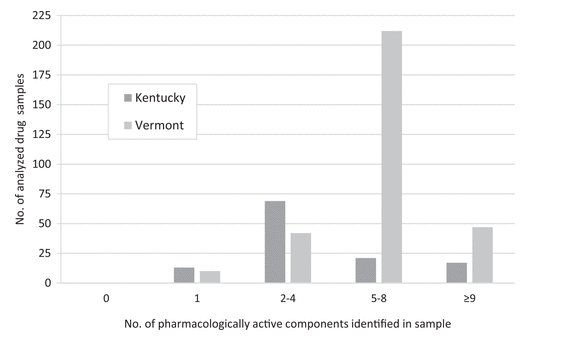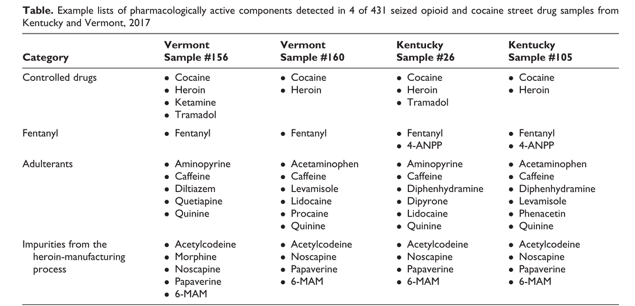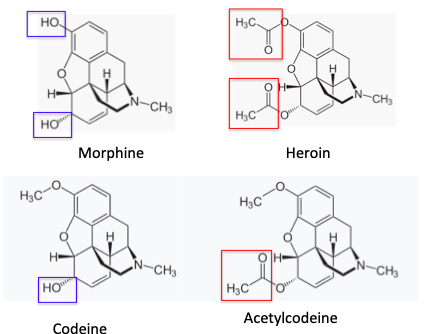
ACSH friend Dr. Vanila Singh, the former Chief Medical Officer for the Office of the Assistant Secretary for Health at the U.S. Department of HHS (1), and a staunch supporter of the rights of chronic pain patients has always known the real story:
"Today’s opioid crisis is all about the synthetic opioids"
Vanila Singh, M.D., UCLA Health, June 2019
But the story has changed in a twisted way. By now, it is common knowledge that fentanyl (2), an ultra-potent "synthetic opioid" (3) is responsible for most overdose deaths in the US (4). To make matters worse, fentanyl is not alone – far from it. There is new evidence that a mind-boggling number of other adulterants, some of which are pharmacologically active, are also present.
This is the gist of a new paper by Dr. Singh (who recently returned to her former position at Stanford University) (5) and colleagues, which was published in the November 18th issue of Public Health Reports (6). The paper entitled The Emerging Role of Toxic Adulterants in Street Drugs in the US Illicit Opioid Crisis, examines four samples of street drugs that were supposed to be cocaine or an opioid that were seized in Kentucky and Vermont in 2017.
In short – it's scary out there.
Some key findings in the study include:
- Drug overdose deaths almost tripled (23,500 to 70,200) from 2002-2017
- This surge in deaths was led by fatalities attributed to opioids (an increase of more than 35,000)
- Between 2016-7 overdose deaths continued to rise – by 12%.
- But these deaths were not attributable to either prescription drugs or heroin.
- During that time deaths from cocaine and other stimulants (e.g., methamphetamine) both rose by one-third – a likely contributor to the 12% increase in overall deaths.
- This is where the adulterants may come in.
ADULTERANTS WERE FOUND IN ALL SAMPLES THAT WERE STUDIED (FIG. 1)
"A total of 301 of 311 (97%) samples collected in Vermont and 107 of 120 (89%) samples collected in Kentucky contained multiple additional pharmacologically active components."
Singh, et. al, Public Health Reports (2019)

Figure 1. The number of pharmacologically active components identified in a sample. Source: Singh, et.al, Public Health Reports, https://doi.org/10.1177/0033354919887741 (November 18, 2019)
It is virtually certain that this trend holds true for many, if not most street drugs in the US.
Singh writes "the problem of adulterants is exacerbated by the fact that most commercially available toxicological analyses identify a limited number of adulterants in illicit drug samples. Consequently, adulterants often go undetected, and their presence tends to be underreported."
In other words, the analytical methods used in the study are superior to those routinely used and will pick up additional components. The Vermont and Kentucky samples were analyzed with a sophisticated instrument called a quadrupole time-of-flight mass spectrometry – a method that can identify a complex mixture of trace adulterants that would be missed by standard analytical instruments.
WHAT ARE THE ADULTERANTS?
I thought I'd focus on the myriad of the additives and impurities found in these samples. It will give you an idea of what the people who make and cut street drugs are willing to use and also an idea of the proficiency of the "chemists" who are synthesizing these drugs. (Hint: they suck).
Table 1 (below) lists all of the adulterants found in the four samples that were analyzed (7).

Table 1. Adulterants found in four of the 431 samples seized in Vermont and Kentucky. In every case fentanyl is present, but so is just about everything else in a CVS store.
The list is interesting. Let's take a look at what's in there:
- Ketamine is a club drug with multiple psychotropic properties. It is being studied as a novel antidepressant.
- Tramadol (aka Ultram) is a pseudo-opioid analgesic that is considerably less potent than oxycodone or hydrocodone.
- Aminopyrine (aka aminophenazone) is an old drug that was used to reduce pain and fevers. It was withdrawn in 1999 because of safety concerns. It is still available in other countries.
- Diltiazem (Cardizem) is a widely-used blood pressure medication that belongs to the calcium channel blocker class.
- Quetiapine (Seroquel) is a schizophrenia drug that is also used off-label as an adjuvant to other drugs, for example, antidepressants and sedatives.
- Acetaminophen is Tylenol.
- Levamisole (Ergamisol) is a deworming drug with nasty side effects. It was also used to fight colon cancer but was taken off the market in 2000 due to toxicity. It is sometimes used in livestock.
- Lidocaine and procaine are local anesthetics. At a high enough dose, they can cause an irregular heartbeat, which can be dangerous.
- Quinine is a malaria drug with a host of side effects, mostly gastrointestinal. It is very unpleasant to take.
- Phenacetin is a derivative of Tylenol. Like Tylenol, it reduces pain and fever. Also like Tylenol it is a terrible drug. It was banned in the US in 1983.
- Acetylcodeine provides a good example of how impure street drugs can be (below).

Impure morphine may contain codeine (both are made by the poppy plant). Morphine is converted to heroin (top reaction) by an acetylation reaction (blue box ---> red box). Any codeine present will undergo the same reaction, forming acetylcodeine. So acetylcodeine is actually an impurity of an impurity.
- 6-MAM (6-Monoacetylmorphine) is an impurity resulting from the incomplete acetylation of morphine (8). Converting morphine into heroin requires that both hydroxyl groups (blue box) be acetylated (red box, this is why heroin is also called diacetyl morphine). But if the reaction isn't complete 6-MAM forms.
ACSH CHALLENGE!!! If you can tell me why the "bottom" hydroxyl group of morphine is preferentially acetylated I will give you $1 million of Alex Berezow's money (9).

- Noscapine is also found in the poppy plant. It "comes along for the ride." Noscapine is a weak opioid used in cough syrups. It is not approved in the US.
- Papaverine (Pavabid) is a vasodilator that is approved in the US for lowering blood pressure.
- Diphenhydramine is Benadryl.
- Dipyrone (Metamizole) is an antiinflammatory and analgesic drug that is banned in the US.
- 4-ANPP is the synthetic precursor of fentanyl. Even though the chemical structure looks similar it has no opioid properties. 4-ANPP is an impurity resulting from an incomplete acylation reaction (below).

Given the concoction of junk found in the seized samples, you might expect that they might be harmful. You would be right.
Health issues reported in the United States to be related to these adulterants include anemia, bone marrow damage, cancers, cardiac arrhythmias, hemolytic uremic syndrome, leukopenia, multifocal inflammatory leukoencephalopathy, neutropenia, and renal failure.
Singh, et. al, Public Health Reports (2019)
But the combination of multiple drugs poses another problem – drug-drug interactions. For example, Benadryl is known to slow the metabolism of certain opioids, which could contribute to a fatal overdose (10):
Yet the danger lies not only in the direct toxicity of these adulterants but also in their unpredictability and their potential for unknown or unanticipated synergistic reactions with the opioid or other nonopioid components, all of which increase the risk for adverse health consequences, including death.
It is bad enough to cope with fentanyl-spiked street drugs. Throw in a bunch of drugs and other junk and things get worse fast. Just what we don't need.
NOTES:
(1) Dr. Singh's tenure at HHS was from June 2017 through July 2019.
(2) When I use the term fentanyl it refers to illicit fentanyl and its analogs, not pharmaceutical fentanyl.
(3) "Synthetic opioids," is a made-up term that refers to illicit fentanyl and its analogs. The term is scientifically incorrect as used. Morphine is a natural opioid. Heroin is a synthetic opioid, just like fentanyl. Heroin, even though it is not naturally occurring, does not belong in the same family as fentanyl, it belongs with morphine (from which it is derived). Whether a drug is made in a lab or extracted from a plant is irrelevant. See 'Synthetic' And 'Opioids': Two Useless, Confusing Terms That Need To Go
(4) In some states, virtually all opioid overdose deaths are due to fentanyl. See A Little State Debunks A Big Lie: The DEA's Opioid Scam.
(5) Singh is an associate professor of anesthesiology, perioperative and pain medicine at Stanford University Medical Center.
(6) Public Health Reports is the official journal of the U.S. Surgeon General
(7) This project is part of a collaborative effort of US State Department and the Colombo Plan, an independent intergovernmental organization based in Sri Lanka. Its purpose was to identify toxic adulterants and gauge their harm globally.
(8) There are few reactions easier to carry out than an acylation. This might give you an idea about the proficiency of the hacks that are synthesizing fentanyl if they can't even get this right.
(9) He's not quite at a million - yet. Only $998,500 to go. We industry shills don't make as much as you'd think.
(10) This topic is beyond the scope of the article.



